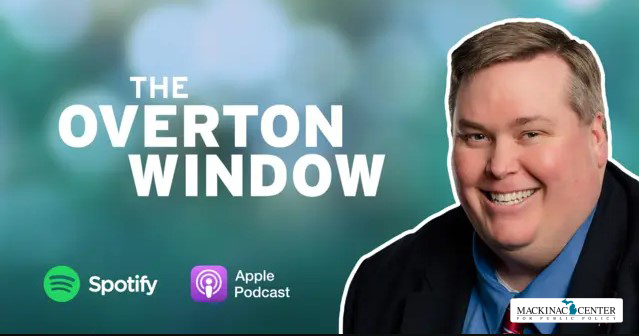This article was originally written by James M. Hohman, Director of Fiscal Policy, and published by the Mackinac Center for Public Policy.
Whether it is the passage of a universal ESA or the largest tax reform in Iowa’s history, Governor Kim Reynolds and the Iowa Legislature have made some big changes that have made Iowa a great place to live, work, and raise a family.

Listen in to The Overton Window Podcast featuring our very own ITR Foundation Policy Director John Hendrickson.
Two years ago, no state gave all parents money to help educate their children. Few states went from a graduated income tax system — where people pay higher tax rates as they earn more income — to a flat-rate income tax where all income is taxed at the same rates. Iowa did both, and I talk about that with John Hendrickson of the Iowans for Tax Relief Foundation for the Overton Window podcast.
The Iowa legislature approved a universal education savings account bill, which will give parents roughly $7,600 per child to spend as they choose on education. “This has been a historic year for school choice in Iowa,” Hendrickson says.
Hendrickson says the pandemic changed politics. “When COVID first hit, Gov. Kim Reynolds basically heard from Iowa parents that they wanted their kids in school. A lot of kids were struggling with remote learning, and we’ve seen some of the consequences of that,” Hendrickson says.
They went so far this year in response to failures in the previous session. “Last year, the governor had an ESA bill that was much milder than this was. It passed the Senate but it stalled in the House because several rural Republicans opposed it,” Hendrickson says.
The governor did not appreciate this and campaigned against those legislators during last year’s Republican primary election. “Several key Republican legislators lost those primaries and it was because of the school choice issue, including the chair of the House education committee,” Hendrickson says.
He also credits the governor for the move to flat income taxes.
“Iowa had a nine-bracket, progressive income tax. We had some of the highest taxes in the nation. Our top rate was close to 9%. Our corporate rate at one time was 12%, which I believe was the highest in the nation. By 2026, Iowa will have a 3.9% flat tax, and our corporate income tax is also being phased down.” Hendrickson says.
“A key factor for Gov. Reynolds has been prudent budgeting. The reason why Iowa has been able to make these large achievements and pro-growth tax reform is because she’s kept spending very limited,” Hendrickson says.
Nothing here seems too far out of the ordinary in politics. Yet scholarships for all students and flat income taxes are out of the ordinary. People talked about them, but policymakers rarely enacted them. What does Hendrickson think about why the Overton Window shifted?
“One term — I can’t remember where I heard it from — but it was called Red State Federalism,” Hendrickson says, “You have a really fierce competition among governors, whether it’s Gov. Reynolds or Gov. DeSantis, who are doing some really good conservative free market policies.”
Domestic migration also played a role in encouraging Iowa lawmakers to go further than they had before. “There’s a mass exodus going on from these blue states. People are leaving both Minnesota and Illinois as well as other blue states across the country,” Hendrickson says.
Another factor is competition among red states. “The no income tax states of Texas and Florida, but even our neighbors in South Dakota. South Dakota has grown its population more than we have and that’s a no income tax state.”
Iowa’s history is not as Republican as its current reputation. “If you look at the history of Iowa, Iowa was largely what we would call a purple state. We were kind of half Republican, half Democrat,” Hendrickson says. Now that it is more of a solid red state, there are opportunities to move substantial legislation.
He credits Reynolds’ leadership through the pandemic and since. “She understood that the economy had to be open. She understood that kids needed to be in the classroom,” Hendrickson says.
“The governor understood that the best way to make Iowa more competitive was to have a more competitive tax code. She understood that these other states were cutting taxes and that Iowa could not be complacent,” Hendrickson says.
He also thinks that Senate Majority Leader Jack Whitver showed a lot of leadership. “There was more political support for serious income tax reduction. This had been a big issue for the business community and for individuals as well who wanted tax relief. They weren’t going to just tinker around the edges and maybe mess with tax brackets. They wanted to make transformational changes in order to make Iowa a better place. They delivered on what they said they were going to do,” Hendrickson says.
“I think that this formula of lower tax rates, reining in government spending, more opportunities, more choices for families is a system that’s going to pay off in the long run by creating more freedom and opportunity,” Hendrickson says.
He helped these changes get passed into law as an advocate with the Iowans for Tax Relief Foundation.
“We’ve been really fortunate to be able to have a seat at the table in some of these conversations of tax reform,” Hendrickson says, “As an organization, we’ve been able to reach out to Iowans and help them to understand these issues and kind of share some of the broader points of why conservative policies matter.”
Check out the conversation at the Overton Window podcast.
